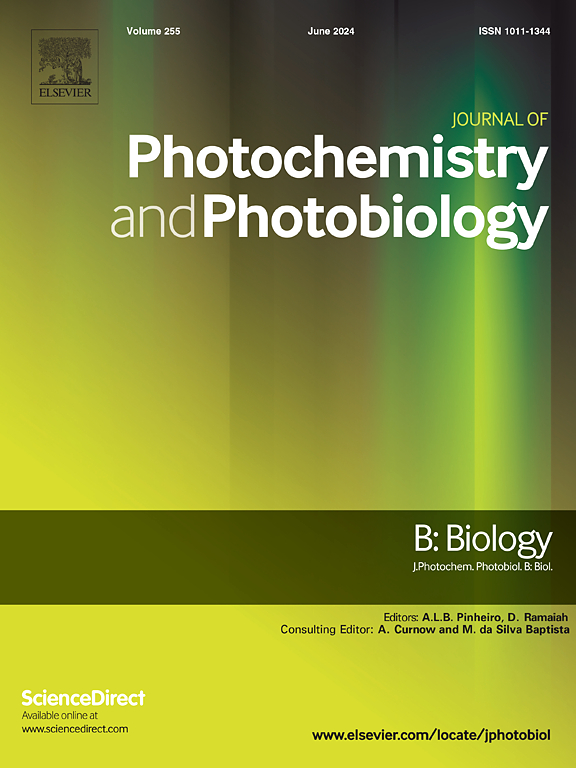Restoration of carious dentin using diode irradiation on unmodified and chitosan nanoparticle-modified adhesive before LED polymerization: A SEM, FTIR, and μTBS evaluation.
IF 3.7
2区 生物学
Q2 BIOCHEMISTRY & MOLECULAR BIOLOGY
Journal of photochemistry and photobiology. B, Biology
Pub Date : 2025-09-16
DOI:10.1016/j.jphotobiol.2025.113265
引用次数: 0
Abstract
Aim
To investigate the restoration of caries-affected dentin (CAD) using adhesive modification technique via diode laser (DL) irradiation of unmodified and modified adhesive with Chitosan nanoparticles (CHNP) before light emitting diode (LED) polymerization, and CHNPs modified adhesive+LED polymerization without DL on micro-tensile bond strength (μTBS), Degree of conversion (DC) and resin tag length (RTL).
Material and methods
Forty-four human mandibular molars were obtained, and CAD was exposed according to ICDAS criteria 5. Teeth were positioned vertically within the auto-cure acrylic resin and randomly distributed into four categories according to the adhesive modification (n = 11). Group1-Etch(E) + Bond(B) + LED,Group 2-E + B(CHNP) + LED, Group 3-E + B + DL + LED and Group 4-E + B(CHNPS) + DL + LED. All samples were restored using composite buildup followed by thermal aging. Surface characterization of CHNP with Energy-dispersive spectroscopy (EDS) was assessed along with RTL via scanning electron microscopy (SEM). μTBS and failure modes were analyzed utilizing a universal testing machine (UTM) and stereomicroscope, respectively. The DC was quantified using a Fourier Transform Infrared Spectroscopy (FTIR). A one-way analysis of variance, complemented by Tukey's post hoc test, was implemented for comparisons among the investigated groups (p < 0.05).
Results
Group 4-E + B(CHNP) + DL + LED (107.43 ± 1.55 μm) presented the longest RTL with a score of grade 3 and the highest bond strength (11.54 ± 0.37 MPa). Whereas, Group 1 (E + B+ LED) displayed the shortest RTL (76.63 ± 0.82 μm) and lowest μTBS (9.31 ± 0.17 MPa). The adhesive irradiated with DL before LED polymerization in Groups 2 and 4 presented comparable DC (p˃0.05).
Conclusion
Pre-irradiating both unmodified and modified adhesives with chitosan nanoparticles using a diode laser before LED polymerization seems to be an effective approach. This technique enhances the material's mechanical properties by improving adhesive penetration, which in turn affects the length of resin tags,μTBS, and DC.
LED聚合前未改性和壳聚糖纳米颗粒改性胶粘剂二极管辐照修复牙本质龋病:SEM、FTIR和μTBS评价。
目的:通过二极管激光(DL)照射未改性和改性壳聚糖纳米颗粒(CHNP)的胶粘剂,观察未改性和改性壳聚糖纳米颗粒(CHNP)在发光二极管(LED)聚合前修复龋病牙本质(CAD),以及CHNP改性胶粘剂+LED无DL聚合的微拉伸粘结强度(μTBS)、转化度(DC)和树脂标签长度(RTL)的变化。材料与方法:取人下颌磨牙44颗,按照ICDAS标准进行CAD暴露5。将牙齿垂直放置在自动固化丙烯酸树脂中,根据粘接剂改性随机分为四类(n = 11)。Group1-Etch (E) +债券(B) +领导,集团双电子+ B (CHNP) +领导集团3 E + B + DL +领导和集团4 E + B (CHNPS) + DL +领导。所有样品都采用复合材料堆积,然后进行热老化。利用能量色散光谱(EDS)和扫描电子显微镜(SEM)对CHNP进行了表面表征。μTBS和失效模式分别采用通用试验机(UTM)和体视显微镜进行分析。利用傅里叶变换红外光谱(FTIR)对直流电进行定量分析。结果显示,4-E + B(CHNP) + DL + LED(107.43±1.55 μm)组的RTL最长,为3级,结合强度最高(11.54±0.37 MPa)。组1 (E + B+ LED)的RTL最短(76.63±0.82 μm), μTBS最低(9.31±0.17 MPa)。2组和4组在LED聚合前用DL辐照后的DC值相当(p < 0.05)。结论:在LED聚合前,用二极管激光对未改性和改性的壳聚糖纳米颗粒进行预照射是一种有效的方法。该技术通过提高胶粘剂的渗透性来提高材料的机械性能,从而影响树脂标签、μTBS和DC的长度。
本文章由计算机程序翻译,如有差异,请以英文原文为准。
求助全文
约1分钟内获得全文
求助全文
来源期刊
CiteScore
12.10
自引率
1.90%
发文量
161
审稿时长
37 days
期刊介绍:
The Journal of Photochemistry and Photobiology B: Biology provides a forum for the publication of papers relating to the various aspects of photobiology, as well as a means for communication in this multidisciplinary field.
The scope includes:
- Bioluminescence
- Chronobiology
- DNA repair
- Environmental photobiology
- Nanotechnology in photobiology
- Photocarcinogenesis
- Photochemistry of biomolecules
- Photodynamic therapy
- Photomedicine
- Photomorphogenesis
- Photomovement
- Photoreception
- Photosensitization
- Photosynthesis
- Phototechnology
- Spectroscopy of biological systems
- UV and visible radiation effects and vision.

 求助内容:
求助内容: 应助结果提醒方式:
应助结果提醒方式:


